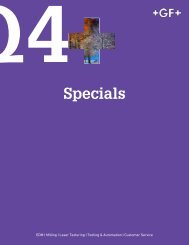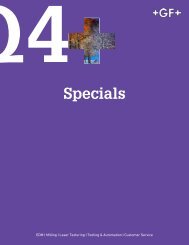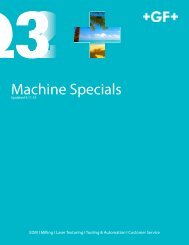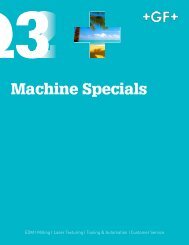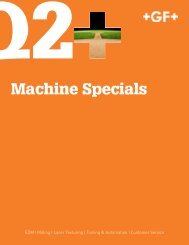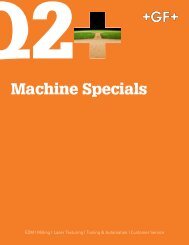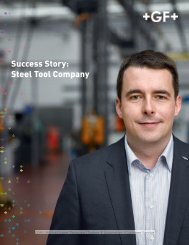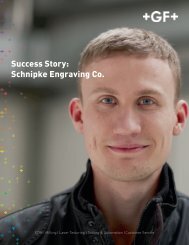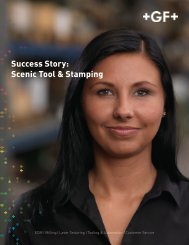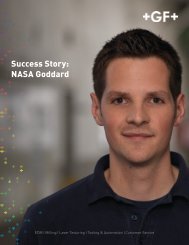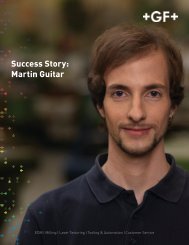Custom Etch, Inc.
Create successful ePaper yourself
Turn your PDF publications into a flip-book with our unique Google optimized e-Paper software.
process are automatically extracted by vacuum to guarantee a<br />
clean process.<br />
“The LASER machines are basically 5-axis milling machines<br />
with lasers instead of milling heads,” explained Melonio.<br />
“However, GF AgieCharmilles created a completely new proprietary<br />
software to run the laser heads from common IGES<br />
and STEP files. Programming is easy and basically requires<br />
only the same programming skills as would be needed to<br />
machine a simple component on a conventional CNC machine<br />
tool.”<br />
Rhino is <strong>Custom</strong> <strong>Etch</strong>’s preferred mapping/imaging software<br />
used to create surface designs and transfer them on to mold<br />
cavity surfaces for laser texturing. These same files are the<br />
ones used by the machinist that cut the tool cavity shape on<br />
milling machines.<br />
According to Melonio, the key to the laser-texturing operation<br />
is positioning the laser’s focal point at the correct distance<br />
from the workpiece surface. Material ablation rate is based<br />
on the frequency and power setting of the laser. Power settings<br />
can be adjusted anywhere from 0 to 100 percent, and the<br />
frequency from a level of ten to 90, for instance, to determine<br />
how fast the laser will ablate/cut material.<br />
Because they use fiber lasers, the systems are extremely precise<br />
and can remove microns at a time. This allows <strong>Custom</strong><br />
<strong>Etch</strong> to make very light and shallow cuts or not make a cut<br />
at all, but instead use the lasers to only change the color of a<br />
part’s surface for strictly aesthetics if so desired.<br />
With its most recently acquired LASER 1200 5Ax, <strong>Custom</strong> <strong>Etch</strong><br />
increases the range of part sizes to which it can apply surface<br />
texturing. The machine’s table measures 31.5” in diameter and<br />
handles workpieces weighing up to 3,747 lbs.<br />
<strong>Custom</strong> <strong>Etch</strong>’s LASER 1000 5Ax is fully automated with an integrated<br />
GF AgieCharmilles pallet changing system that accommodates<br />
six modular pallets from System 3R. And according<br />
to Melonio, automation is the one factor that definitely makes<br />
the technology economical for the shop and completely justifies<br />
the investment.<br />
The pallet system uses six 11.02” square pallets that each<br />
hold workpiece fixtures an outside shop developed for <strong>Custom</strong><br />
<strong>Etch</strong>. As opposed to vises, the adjustable fixtures allow <strong>Custom</strong><br />
<strong>Etch</strong> to effortlessly load and unload workpieces.<br />
In operation, the laser machine runs an automatic probe<br />
cycle, and the part program is such that every part locates in<br />
the same place on the pallet thanks to the custom fixtures.<br />
Removing parts is as simple as loosening a couple of screws,<br />
sliding the finished part out and placing a new one into the<br />
fixture.<br />
“For our type of work, it would be tough to make money with<br />
the laser machine if it didn’t have the pallet system. Without<br />
such automation, parts would have to be manually loaded one<br />
at time into the machine, which would add huge labor costs<br />
and time to the process,” explained Melonio. “Plus, once pallets<br />
are loaded, the system basically runs unattended.”<br />
To illustrate the value of the pallet system, Melonio cites having<br />
to produce 40 soft drink plastic bottle molds – a job that<br />
entailed texturing 80 mold halves (cores and cavities) and 40<br />
base pushups. For this particular job, the shop had to process<br />
all 80 halves and all 40 base pushups through the GF<br />
AgieCharmilles 5-axis laser-texturing machine in a matter of<br />
three days to make the required delivery time. And according<br />
to Melonio, the only way the shop accomplished the task was<br />
being able to have only one person load and unload pallets<br />
while the machine continued to work non-stop and unattended.<br />
Typical part sizes run on the LASER 1000 5Ax machine measure<br />
up to 8.5” x 10.63”, so the shop uses every workable<br />
inch of its pallets. About 200 molds per week are processed<br />
through the laser machine, and the system has increased<br />
the shop’s throughput month after month without the need to<br />
dramatically increase shop floor size or workforce.<br />
However, it should be noted that <strong>Custom</strong> <strong>Etch</strong> uses its laser<br />
machines to impart complete surface textures only some of<br />
the time. Instead, explained Melonio, the lasers will most<br />
often be used first on a part, followed by the acid etching<br />
process. The reason, he said, is that imparting an 0.008”-deep<br />
pattern in a soft drink bottle mold, for instance, would take<br />
about 1.5 hours per one mold half using only laser texturing.<br />
Such a processing time is reasonable for one or two parts, but<br />
consider if the job required 60 molds with a total of 120 halves.<br />
For its dual texturing technology processing, <strong>Custom</strong> <strong>Etch</strong> will<br />
apply an acid resistant paint on to the mold cavity surfaces. It<br />
then laser textures the desired pattern on to the parts, but in<br />
such a way as to only remove the paint, not actual part material.<br />
The operation takes only minutes as opposed to hours and<br />
basically serves the same purpose as the wax transfer does in<br />
traditional chemical etching.<br />
With traditional chemical etching, a film negative of a design<br />
is etched into a magnesium plate. A wax substance is then<br />
burnished into the plate and the excess removed, leaving only<br />
the wax in the design etching. Pottery tissue is burnished on<br />
to the plate, and when the tissue is lifted off, the design comes<br />
with it, so to speak. This 2D wax rendering of the texture<br />
design can then be wrapped around a 3D surface, such as the<br />
cavity of a mold.



